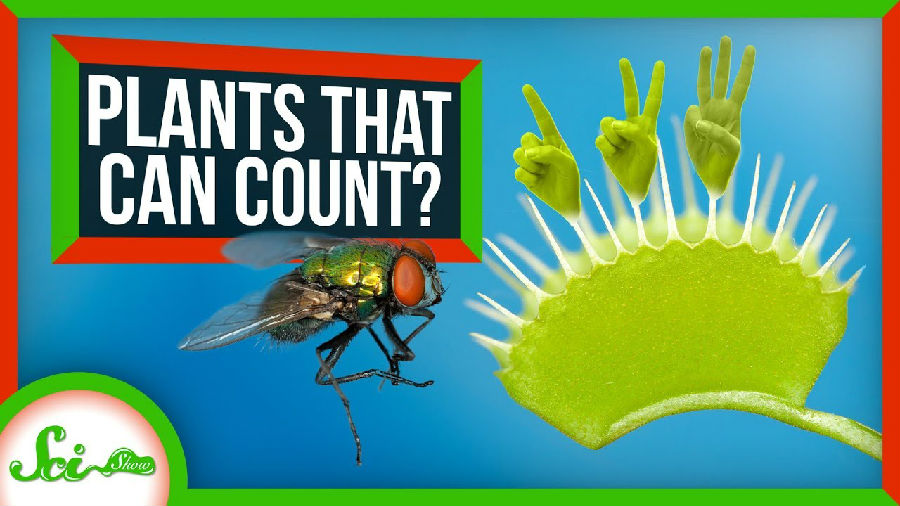You might have heard that plants can count. And yeah, I know, it sounds silly to ask if that's true.
大家或许听说过,植物会数数。没错,我知道问真假听起来很傻。
But even the New York Times has called Venus flytraps a plants that can count.
但就连《纽约时报》都称捕蝇草是一种会数数的植物。
The thing is...they can, but it's not counting the way you know it.
它们真的会,只是方式不一样。
Which is to say, they don't have some kind of mental representation of numbers in their brains,
也就是说它们的大脑中不存在对数字的某些心智表征,
because as far as we know they don't have brains, they're not sentient. We're not talking like Groot here.
因为据我们所知,它们没有脑子,它们也没有意识。我们不是在说Groot。
Can Groot count? There's evidence for some sort of counting mechanism in plants, though
那么Groot会数数么?虽然有些证据表明植物有某种计数机制
and a lot more work needs to be done to properly understand it.
但要正确理解它,还有很多工作要做。
This whole idea of counting plants went viral after a 2016 paper in Current Biology.
2016年一篇论文发表在《Current Biology》后,会数数的植物这一想法走红。
The title of the study itself literally has the words "Venus flytraps count" in it.
该研究的标题中出现了‘捕蝇草数数’这样的字眼。
So like, you can't really blame the headline writers here.
你也不能责怪起标题的作者。
And yes, we're talking about those infamous flytraps that snap up unsuspecting flies with their leafy-mouths.
没错,我们正在谈论的就是那些臭名昭著的捕蝇草,它们用长着叶子的嘴巴捕捉毫无戒心的苍蝇。
You see, the study found that an insect needs to bump small trigger hairs on the plants' leaves
你看,该研究发现一只昆虫需要撞击植物叶子上的小刺针至少五次
at least 5 times before the plant would begin secreting enzymes to digest it.
植物才会开始分泌酶来消化它。
And this built on knowledge already known within the botany community
植物界早就知道
that the plants close those leaf-mouths if an insect bumps trigger hairs twice within 15 to 20 seconds.
如果昆虫在15到20秒内撞击刺针两次,那么植物就会关闭叶口。
If the plants can discern one or five different triggerings, well, they're counting, right?
如果植物可以分辨出一次还是五次触发,那么它们就会数数,不是么?
And presumably, that means they think about and process numbers somehow which would mean they'd have to think.
这或许意味着它们思考并处理数字,也就意味着它们需要思考。
Well, as awesome as the idea of sentient plants might seem,
植物有意识这种想法很棒
they're probably not thinking or really understanding numbers, not the way we do, anyway.
它们可能不像我们那样思考或真正理解数字,这也很棒。
You see, your brain actually has specific neurons that fire when you look at certain quanities
人类的大脑实际上有特定的神经元,当你看到特定的数量时,它们会被激活

one set will fire when there are three lemon drops on a plate, another when there are four.
当盘子里有三颗柠檬汁时,一只神经元会被激活,当盘子里有四颗时,另一只就会被激活。
Intriguingly, these are different than the neurons that fire when you simply look at numbers written out.
有趣的是,这些神经元和当你仅仅看着写出来的数字时会被激活的那些是不一样。
But both seem to give you some kind of mental representation of the amount.
但两者似乎都给了你某种数量的心理表征。
There just doesn't seem to be much concrete evidence for these kinds of mental representations of numbers in plants, though
只是似乎没有多少具体的证据来证明植物对数字的这种心理表征
at least one study says you can never be sure.
至少有一项研究表明,你永远无法确定。
What plants do have are sophisticated biological mechanisms that enable them to react to changes in their environment.
植物们所拥有的是复杂的生物机制,能够让它们对环境的变化产生反应。
And while these responses may look like plant intelligence at first glance,
虽然这些反应乍看像是植物智慧
they fall short of what you and I might associate with conscious thinking. There are some similarities, though.
但它们缺乏人类可能会联想到有关意识思考的东西。虽然它们之间有些相似性。
Like, both you and plants can transmit information quickly thanks to electrical signals called action potentials.
比如,人类和植物可以快速传输信息,这多亏了被称为动作电位的电信号。
The process isn't exactly the same for plants and humans since the chemicals involved are a little different.
这个过程对植物和人类来说并不完全相同,因为所涉及的化学物质略有不同。
But they're similar, and they're how a flytrap counts;
但它们很相似,它们是捕蝇草数数的方式;
it generates and transmits action potentials every time a trigger hair is touched.
每次触碰到刺针时,它就会产生并传输动作电位。
The number of action potentials not only dictates if a trap should close but also how much digestive juice it should secrete,
动作电位的数量不仅决定了陷阱是否应该关闭,还决定了陷阱应该分泌多少消化液,
presumably, more triggering implies a larger insect that will require more enzymatic activity to break down.
更多次的触发可能意味着一只需要更多的酶活性来分解的大昆虫。
Basically, having a measure of the size of their meal lets them meter their investment in it so they don't waste energy.
从根本上说,有一个衡量食物大小的方法让它们能够衡量自己在食物上的投资,这样就不会浪费能量。
But the electrical communication networks in plants are much simpler than humans and other animals
但是植物的电子通讯网络比人类和其他动物要简单得多
they're not considered true nervous systems.
它们并不被认为是真正的神经系统。
Those signals never arrive at some central hub or brain where they're processed and translated into action.
这些信号永远不会到达某个中枢或大脑,中枢或大脑负责处理这些信号并转化为行动。
So even if we know that Venus flytraps can count and why, how it counts is still up for investigation.
因此,即使我们知道捕蝇草是会数数的,以及其中的原因,但它数数的方式仍有待研究。
And it's not just the Venus flytrap. Many other plants use action potentials and other types of electrical signals.
不仅仅是捕蝇草,很多其他植物也利用动作电位和其他类型的电信号。
And even without brains, plants can do things that involve some pretty impressive math.
即使没有大脑,植物也可以做一些令人印象深刻的数学运算。
A 2013 study used mathematical models to show that a small mustard relative
一项2013年的研究利用了一些数学模型展现一个小芥末亲缘植物
can do something akin to division to partition its food so it lasts through the night.
可以做类似于分割的事情,把食物分成几份,这样食物就可以保存一整晚。
Other plants have the equivalent of an internal thermostat that lets them regulate their temperature.
其他植物也有类似的内部恒温器,可以让它们调节自己的温度。
So yeah, so plants can't really count numbers or think about them the way that we do, they're still pretty remarkable.
所以没错,植物并不会真的数数或是像我们这样思考,但它们仍然非常了不起。
And they still "know" how much their little hairs get pushed around by a fly.
并且它们仍然“知道”周围的苍蝇推了它们的刺针几下。
Thanks for watching this episode of SciShow, which was brought to you by another remarkable lifeform, SR Foxley!
感谢收看本期《科学秀》,本期节目由SR Foxley赞助播出。
SR is our longest running Patreon President of Space and we appreciate everything he's done to help keep SciShow running.
SR是我们的赞助人,感谢他为这个节目所做的一切。
Thanks SR! If you want to check out our community of patrons and maybe become one yourself, just head on over to patreon.com/scishow.
如果你想加入我们赞助人社区,只需移步
patreon.
com/
scishow。


